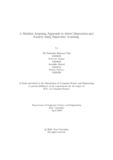| dc.contributor.advisor | Alam, Md. Ashraful | |
| dc.contributor.author | Ullas, Md Tahmidur Rahman | |
| dc.contributor.author | Begom, Mariyam | |
| dc.contributor.author | Ahmed, Anamika | |
| dc.contributor.author | Sultana, Raihan | |
| dc.date.accessioned | 2019-06-30T05:19:34Z | |
| dc.date.available | 2019-06-30T05:19:34Z | |
| dc.date.copyright | 2019 | |
| dc.date.issued | 2019-04 | |
| dc.identifier.other | ID 15101038 | |
| dc.identifier.other | ID 15101003 | |
| dc.identifier.other | ID 15101052 | |
| dc.identifier.other | ID 15101139 | |
| dc.identifier.uri | http://hdl.handle.net/10361/12274 | |
| dc.description | This thesis is submitted in partial fulfillment of the requirements for the degree of Bachelor of Science in Computer Science and Engineering, 2019. | en_US |
| dc.description | Cataloged from PDF version of thesis. | |
| dc.description | Includes bibliographical references (pages 33-35). | |
| dc.description.abstract | Depression, a major depressive disorder and anxiety are common medical illness
which cause several symptoms that a ect the way a person feels, thinks, and the
way he/she acts. These disorders are not only hard to endure, but are also risk
factors for heart disease, panic attacks, dementia, and thus causing severe distress
and functional impairment.Overall, more than 50% of the general population in
middle and high-income countries su ers from at least one of these mental disorder
at some point in their lives. In order to detect these disorders at an early age, we
have proposed a model that uses a standard psychological assessment and machine
learning algorithms to diagnose the di erent levels of such mental disorders. In our
proposed model we used ve di erent types of AI algorithms: Convolutional neural
network, Support vector machine, Linear discriminant analysis, K Nearest Neighbor
Classi er and Linear Regression on the two datasets of anxiety and depression.
These algorithms are used to nd the severity level of anxiety and depression, a
patient is going through. In this paper we compared the results of the ve algorithms
on the two datasets separately on the basis of di erent measurement metrics. The
proposed model achieves the highest accuracy of 96% for anxiety and 96.8% for
depression using the CNN algorithm while its results were compared with the other
ve algorithms we have used for our model. | en_US |
| dc.description.statementofresponsibility | Md Tahmidur Rahman Ullas | |
| dc.description.statementofresponsibility | Raihan Sultana | |
| dc.description.statementofresponsibility | Mariyam Begom | |
| dc.description.statementofresponsibility | Anamika Ahmed | |
| dc.format.extent | 35 pages | |
| dc.language.iso | en | en_US |
| dc.publisher | BRAC University | en_US |
| dc.rights | Brac University theses are protected by copyright. They may be viewed from this source for any purpose, but reproduction or distribution in any format is prohibited without written permission. | |
| dc.subject | Machine learning | en_US |
| dc.subject | Depression | en_US |
| dc.subject | Anxiety | en_US |
| dc.subject | Support vector machine | en_US |
| dc.subject | Linear regression | en_US |
| dc.subject.lcsh | Data mining. | |
| dc.subject.lcsh | Machine learning. | |
| dc.title | A machine learning approach to detect depression and anxiety using supervised learning | en_US |
| dc.type | Thesis | en_US |
| dc.contributor.department | Department of Computer Science and Engineering, Brac University | |
| dc.description.degree | B. Computer Science and Engineering | |

